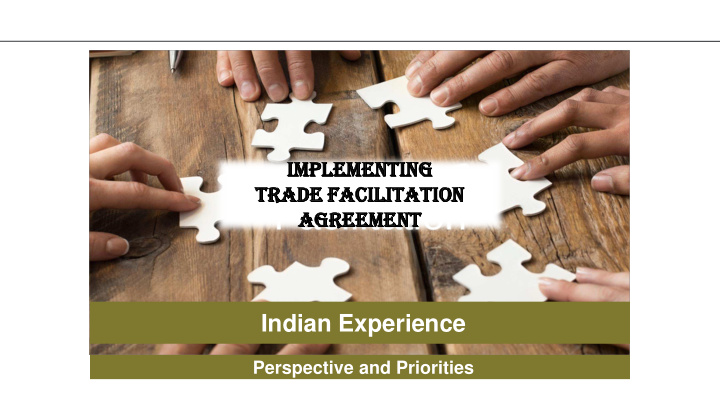



Imp mpleme ment nting ng Trad ade e Fa Facilitat ation on Ag Agreem ement ent Indian Experience Perspective and Priorities
BORDER CLEARANCE ECOSYSTEM PGAs Food Safety Importers Exporters Drug Quarantine Customs Controller Brokers Sea Cargo Air Cargo Environment Wild life CUSTOMS Road Cargo Rail Cargo Textile Security Border Clearances Telecom Radiation Commerce Ports DGFT Carriers PGAs Custodians Banks Trade Bodies Terminal Operators Trade facilitation - Government and Private Stakeholders need to work in tandem
TFA IMPLEMENTATION: INSTITUTIONAL MECHANISM In India, a Three-Tier mechanism for implementation envisaged: National Committee on Trade Facilitation (NCTF) to be chaired by Cabinet Secretary Steering Committee to be chaired by Revenue Secretary and Commerce Secretary Ad-hoc Working Groups to assist with specific provisions. NCTF is mandated with roll out of annual implementation plan 3
NCTF GOVERNANCE STRUCTURE DESIGN PRINCIPLES TFA requires multiple stakeholders to come together in order Wide Representation to ease cross border trade and build the National Trade Facilitation plan. The Structure should facilitate coordinate with various Coordination agencies at various levels to achieve common goals. The structure should facilitate flow of information and Flow of Information knowledge sharing between different agencies and regions. Decision Making The structure should be able to facilitate decision making Authority processes. Public and Private The structure should have representation from both public Ownership and private stakeholders. 4
Responsibility Matrix Infrastructure and Logistics Cross Border Procedures Regulatory Agencies: Ministry of Shipping Customs (Ministry of Finance) Ministry of Civil Aviation DGFT (Ministry of Commerce) Ministry of Railways FSSAI and CDCSO (Ministry of Health) Ministry of Roadways and Highways Animal and Plant Quarantine (Ministry of Agriculture) Ministry of Commerce Bureau of Standards (Ministry of Consumer Affairs) Ministry of Finance Textile Committee (Ministry of Textiles) Wireless Planning and Coordination (Ministry of Communication and IT) and Wildlife Crime Control Bureau (Ministry of Environment and Forests) 5
FOUR PILLARS AND FOUNDATION OF TFA Transparency 1 ( Access to Information ) TFA Technology 2 ( Digital and Detection technologies ) Procedures 3 ( Simplification, Standardization, Harmonization and Risk based 1 2 3 4 approach ) 4 Infrastructure ( Augmentation in Sea Ports, Airports, Railways, Roads, Land Borders ) Coordination 5 5 6 ( Inter-Ministry and Inter-Agency )
TFA PILLARS Transparency Technology Improve IT based Services and Publication of Information Compliance Single Window and Coordinated Border Enquiry Points Management Globally Networked Customs Prior consultation Non-Intrusive Inspection Technologies Opportunity to Comment Scanners, X-ray machines, Measures to Enhance Impartiality Radiation and Nuclear Portals 7
TFA PILLARS Procedures Infrastructure Poor infrastructure at Sea Ports and Uniformity and clarity in Procedures Airports Inadequate infrastructure at CFSs and Uniform documentation requirements ICDs Poor road conditions and congestion Special procedures for Perishables Insufficient rail connectivity to major Faster clearance for e-commerce ICDs shipments Pre-arrival processing and Risk based Lack of testing laboratories at all ports approach 8
Adhoc Working Groups under NCTF Gaps in Legislation for Collaborate with Trade Category B Articles Legislative Increase Awareness Outreach Improve Standards for Changes Officers of all Agencies Category A Articles Trade and Industry Improve Risk Assessment Sea Ports and Airports Identify procedural Time Release Roads and Railways Infrastructure bottlenecks Identify Stakeholder responsibility Study Inland Container Depots Land Customs Stations WCO Methodology
TFA Action Plan – A glimpse at priorities … 1 Improve standards of Category A Articles Developing a single holistic portal which can host all Article 1.2 Regulatory information on behalf of Government Put in place call-centres, which act as Enquiry points, in all Article 1.3 Ministries to handle trade queries. Provide backend support from officers having domain knowledge Make a consultation process compulsory before Rules or Article 2.1 Regulations are changed Bring down the overall cargo release time – below 3 days for Article 7.6 Sea cargo, below 2 days for air cargo and same day for ICDs and Land Customs Stations Create a central repository of original documents in each sea Article 10.2 port, airport, Inland Container Depot or Land Customs Station Convert Category B to A at the earliest 10
TFA Action Plan – A glimpse at priorities … 2 Short Term – Medium Term and Long Term Article 7.5 Strengthen Post Clearance Audit System in Customs. Article 7.7 Increase the number of Authorized Economic Operators Streamline e-commerce policy and minimize documentation Article 7.8 requirement Expedite procedures for perishable goods and augment cold Article 7.9 storage infrastructure Encourage connectivity and co-operation with other Article 12 Customs administrations. Promote Globally Networked Customs TFA Plus – infrastructure, logistics, policy and procedures by various Ministries 11
What have we done so far? Brought cargo release time and transperancy as centre of focus in addition to Revenue Collection Enhanced process efficiency by implementing several modernised procedures SWIFT, Pre-Arrival processing, Direct Port Deliveries (Imports), Direct Port Exit (Exports), Integrated Risk Management, Revamped AEO scheme, Deferred Payment, Reduce paper and rely on digital signatures Renewed and intensive focus on Digital Customs - New Investment into IT Infrastructure and Applications – Technology Refresh through Project Saksham Better coordination amongst various stakeholders in the border clearance ecosystem Customs Clearance Facilitation Committees – feeding information to NCTF Extensive outreach, perception survey and capacity building efforts
Vision Outcome Transform cross border Increase Ease of Doing clearance eco-system through Business Faster Enhance Digitization – Shift efficient, transparent, risk based, coordinated, towards Paperless digital, seamless and Environment technology driven procedures Easier Ensure Simple, Transparent which are supported by and Predictable Legal Regime state-of-the-art sea ports, airports, rail, road and other Improve Investment Climate Cheaper logistics infrastructure. through better infrastructure 13
Thank You
Recommend
More recommend